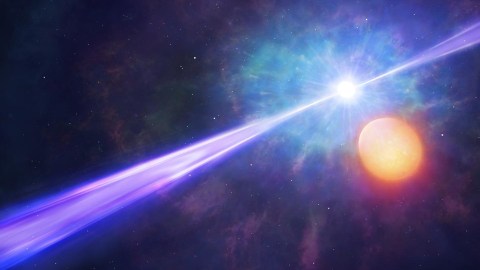Astronomers discover what makes the biggest explosions in space

University of Warwick/Mark Garlick
- Researchers find out how binary star systems produce gamma ray bursts.
- Gamma ray bursts are the brightest explosions in the Universe.
- Tidal effects created in a binary system keep the stars spinning fast and create the bursts.
Giant space explosions capture our imaginations, even though they take place unimaginably far and reach us years later. Now, a team of astronomers figured out how gamma-ray bursts – the biggest and the brightest bangs in the Universe take place.
What the researchers from the University of Warwick in the UK understood is that tidal effects, like those between our own Moon and the Earth, can cause the enormous space explosions.
To arrive at their conclusions, the astronomers looked at simulated models of thousands of binary star systems, which are solar systems where two stars orbit each other. Over half of all stars reside in such arrangements.
The research showed that the spinning of stars in binary systems can cause conditions for a gamma-ray burst to take place.
Specifically, the long gamma-ray bursts (GRB) that the study looked at, happen when a gigantic star that’s ten times bigger than our sun explodes. It goes supernova, collapsing into a neutron star or turning into a black hole, while shooting out a massive jet into space.
The scientists explain that what happens next is that the star flattens out into a disc, keeping its angular momentum. The star’s material falls inwards but this momentum propels it out as a jet – along the polar axis, as explains the press release.
Cosmic death beams: Understanding gamma ray bursts
Another aspect that is important to the creation of the jet – the star has to spin fast enough to launch such materials. While normally stars would slow down their spin quickly, tidal effects from a neighboring star could keep the spin rate high enough to cause gamma-ray bursts.
This effect is similar to the spin interaction between the Earth and its Moon.
The study’s lead author Ashley Chrimes, a PhD student in the University of Warwick Department of Physics, explained that the team’s accomplishment is in figuring out how to predict what types of stars cause “the biggest explosions in the Universe.”
“We found that the effect of a star’s tides on its partner is stopping them from slowing down and, in some cases, it is spinning them up,” Chrimes elaborated. “They are stealing rotational energy from their companion, a consequence of which is that they then drift further away.”
In another takeaway, the scientists found that most of the fast-spinning stars are doing so because of being locked in a binary system.
The binary stellar evolution models used in the study were devised by researchers from the University of Warwick and Dr. J. J. Eldridge from the University of Auckland. Dr. Elizabeth Stanway from the University of Warwick’s Department of Physics pointed out that the models are of previously-impossible sophistication and will be expanded further “to explore different astrophysical transients, such as fast radio bursts, and can potentially model rarer events such as black holes spiralling into stars.”
Check out the paper on this discovery in the Monthly Notices of the Royal Astronomical Society.





